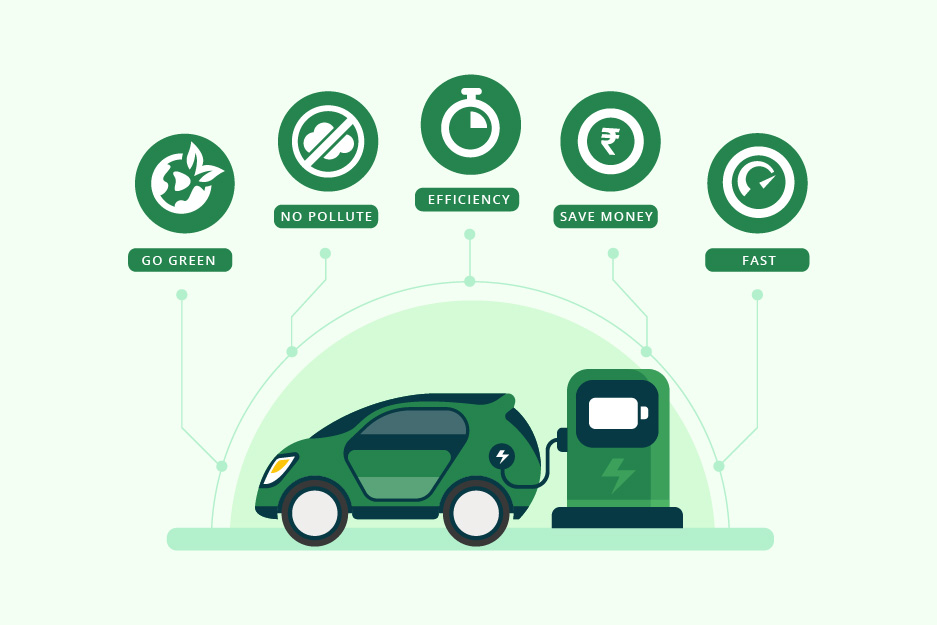Hybrid Electric Vehicles: Components & Types
According to data, around 11 million hybrid electric vehicles are on the roads globally. HEVs have been around for a while. However, their demand has recently grown as more people are becoming environment-conscious. HEVs offer a unique approach that combines an internal combustion engine and an electric motor to bring the best of both worlds. They are eco-friendly as they generate less pollution and are more efficient than petrol or diesel automobiles.
What is a HEV?
HEVs are one of the types of electric vehicles with a fuel engine and an electric propulsion system. It combines an internal combustion engine (ICE) with an electric motor and battery system. The electric motor supplements the internal combustion engine (ICE) during acceleration and cruising. The two power sources work together to provide propulsion. They are designed in a way that makes them more fuel efficient while also having a low emission rate.


Components of a Hybrid Electric Vehicle
An HEV combines the components of a fuel engine and an electric engine. It consists of the following components:
- Internal Combustion Engine
An ICE is similar to engines found in all vehicles, but in HEVs, it is smaller in size. It is the main element responsible for powering the car. It also helps in generating electricity and powering the motor.
- Battery Pack
The electricity that powers the electric motor is preserved in a battery pack. The ICE, or regenerative braking, is used to charge the battery pack made of numerous smaller batteries.
- Electric Motor
The electric motor serves as the secondary power source in an HEV. It is used to provide power to the wheels during acceleration, which helps in improving performance and fuel efficiency. The energy stored in the battery pack helps to power the motor.
- Transmission
The transmission supplies power to the wheels through the vehicle’s electric motor or ICE. It is the same as conventional cars.
- Fuel Tank
A fuel tank stores fuel. An HEV also has an electric motor to power it. The fuel consumption is less than cars which depend completely on petrol or diesel.
How Does a HEVs Work?
Here is a brief outline of how an HEV works. You can learn more about the working of HEVs by taking a comprehensive electric vehicles course.
- It is powered by an electric motor and an internal combustion engine (ICE).
- The electric motor uses the energy stored in the battery pack. The ICE charges the battery pack. It does not need to be plugged into a power source. Both the ICE and the electric motor power the vehicle.
- The engine is supported by additional power from the electric motor, which helps increase efficiency.
- The battery is also used to power the other components of the vehicle, such as headlights, power windows, entertainment systems, etc.
- The advanced technology of an HEV also helps in saving fuel by automatically switching off the engine when idle and starting the engine when the driver presses the throttle.
Types of Hybrid Electric Vehicles
Different types of HEVs are available and focused on the distribution and transmission of power. Some of them are mentioned below.
- Series Hybrid
In series, ICE produces electricity that powers the electric motor. The vehicle’s main power source is its electric motor, while its backup generator is its internal combustion engine (ICE). The engine does not directly power the wheels in this configuration.
- Parallel Hybrid
In a parallel hybrid, a vehicle is powered by an internal combustion engine (ICE) and an electric motor simultaneously. The internal combustion engine (ICE) is the primary power source. However, the electric motor can supply additional power during acceleration or other high-demand conditions.
- Series-Parallel
In a series-parallel hybrid, the electric motor and IC engine can operate separately or together. Depending on the road conditions, this enables the vehicle to drive in parallel or series modes.
- Plugin Hybrid
Like a parallel hybrid, a plugin hybrid features a bigger battery pack that can be charged by plugging into an outlet. Due to this, the car can run entirely on electricity for a short while before switching to hybrid mode.


Advantages of Hybrid Electric Vehicles
There are several advantages to driving a hybrid electric vehicle. Some of them are:
- Fewer Emissions
HEVs run on a combination of traditional and electric engines. This reduces carbon pollution and has less impact on the environment.
- Improved Fuel Efficiency
As there is both an ICE and an electric motor in an HEV, it can run at a lower-than-average engine speed. It reduces fuel use and improves overall efficiency.
- Less Maintenance Cost
Since there is an electric motor, it requires almost zero maintenance due to regenerative braking and other technologies.
- Increased Power
An HEV’s electric motor can enhance its output during acceleration, relieving pressure on the ICE and enabling more productive driving.
Disadvantages of HEVs
Owning a hybrid car comes with certain drawbacks. Here are some potential cons to consider when deciding if this type of vehicle is right for you.
Less Powerful
Hybrid cars often have less powerful engines than conventional petrol cars. This is because it uses a smaller gasoline engine as the main source of power and an electric motor that is not as powerful.
Expensive
Hybrid vehicles are more expensive to buy and maintain than their traditional counterparts. This is due to the cost of developing and producing advanced technology components that power them, including electric motors, batteries, fuel cells, etc.
Higher Cost of Maintenance
The use of two engines and regular technological advancements can make it challenging for mechanics to fix the car, leading to higher maintenance costs than usual. Furthermore, finding a mechanic who is qualified enough to do so can be difficult as well.
Risk of Electrocution
There is a risk of electrocution if users come in contact with exposed wires or terminals in certain areas of the car. This is because it’s powered by electricity.
Hybrid Electric Vehicles in India
One of the reasons why HEVS are becoming popular is their fuel efficiency. Observing the future of electric vehicle in India, many brands have launched their products. Let’s have a look at the below data to learn about the model, price, and fuel efficiency of hybrid electric vehicles.
| Model | Price | Fuel Efficiency |
| Honda City | Rs.18 Lakhs – Rs. 20 Lakhs | 25 km |
| Maruti Suzuki Grand Vitara | Rs. 17 Lakhs – Rs. 20 Lakhs | 28 km |
| Toyota Urban Cruiser | Rs. 15 Lakhs – Rs. 18 Lakhs | 28 km |
| Toyota Camry | Rs. 45 Lakhs | 20 km |
| Lexus NX | Rs. 67 Lakhs – Rs. 74 Lakhs | 18 km |
| Volvo S90 | Rs. 66 Lakhs | 15 km |
It is important to note that these prices and fuel efficiencies are approximate and can vary depending on the conditions, driving, model, etc. Also, this is not a complete list, other hybrid electric vehicles in India are available too.
You can also check the list of electric vehicles in 2023.
Difference Between Hybrid EVs and EV
HEVs should not be confused with electric vehicles. Some of the key differences between the two are as follows:
| Criteria | Electric Vehicle | Hybrid Electric Vehicle |
| Power Source | Electric motor | ICE and Electric motor |
| Range | Lower than HEV | Higher than Electric vehicle |
| Running Cost | Low | High |
| Battery Charging | You need to charge the battery and find a plugin source. | The battery does not need to be charged as it gets charged via regenerative braking. |
| Emissions | Zero | Emits less pollution than conventional care. |
| Maintenance | Less as it has fewer moveable parts | High as it has more moveable parts |
| Vehicle Life | Can be used till the battery lasts | Lasts longer than electric vehicles |
Future Scope of Hybrid Electric Vehicles
Hybrid electric vehicles (HEVs) hold great potential for our future because of their emission-free technologies and charging infrastructure. The same advancements can also let HEVs take advantage of renewable energy sources like wind, solar, and hydroelectricity, which could make them more efficient.
Electric vehicles (EVs) have the potential to make the development of hybrid electric vehicles (HEVs, which use both an electric motor and a gasoline engine) more successful in countries that are starting to limit the usage of petrol-powered cars. Improvements in EV battery technology are needed so that these hybrid cars will be able to travel longer distances while still maintaining sustainability.
Ready to drive your career forward in the electric vehicle (EV) industry? Enroll in our EV course with placement today and gain the skills you need for success
Conclusion
As the world becomes more sustainable, hybrid electric vehicles will grow in importance. Compared to conventional fuel vehicles, HEVs have several benefits, including higher fuel efficiency, lower pollutants, and less expensive maintenance.
FAQs
What is an example of a hybrid electric vehicle?
Examples of popular HEVs include the Kia Optima Hybrid, Toyota Prius and Camry Hybrid, Honda CR-Z, Ford C-Max, Chevrolet Tahoe Hybrid, etc.
Why hybrid is better than EV?
Hybrid vehicles offer a combination of advantages that make them better than electric cars in many scenarios. One major benefit is their extended range. Hybrids generally have longer ranges because they use both gasoline and electricity, whereas EVs rely solely on batteries which need to be recharged every few hundred kilometers/miles.
What is the working principle of HEV?
HEVs use a combination of an internal combustion engine (ICE) and one or more electric motors to power the vehicle. They work together to make the car more efficient. The power is distributed in such a way that it gives maximum performance for any driving situation.
What is a full hybrid vehicle?
Full hybrid vehicles use both a combustion engine and an electric motor to power the car, either together or separately.
What are the main types of hybrid vehicles?
There are four types of hybrid vehicles, series hybrid, parallel hybrid, series-parallel hybrid, and plugin hybrid.
Does a hybrid car need petrol?
Yes, a hybrid car combines a petrol or diesel engine with an electric motor, so it uses more than one type of energy. The two systems work together to make the vehicle move, which leads to using less gasoline and better fuel efficiency compared to regular engines that only use fuel.
Which type of hybrid vehicle is best?
The parallel hybrid system is the best kind of hybrid vehicle since it is powered by an internal combustion engine (ICE) and an electric motor.
Is hybrid better than petrol?
Hybrid cars are better than regular petrol-fueled vehicles because they use less gasoline due to the combination of a gas engine and an electric motor. Additionally, hybrids often require fewer repairs than traditional petrol engines since many components don’t need frequent maintenance or replacement.







